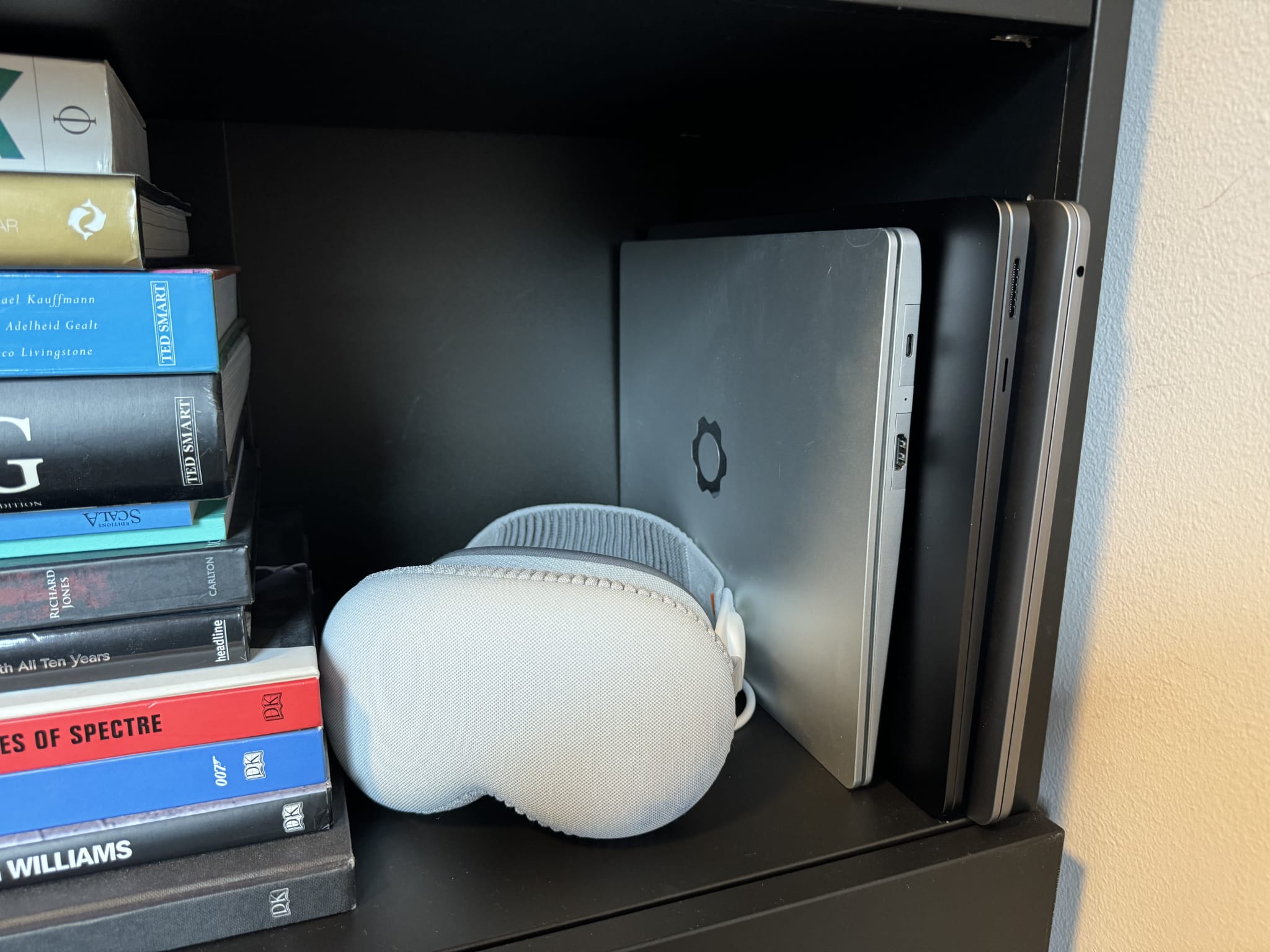Collecting Dust
It has been approximately five months since the launch of the Apple Vision Pro.
In the conclusion of my initial impressions, I stated “The Apple Vision Pro is the most impressive VR/AR headset I have ever used! It is also the most expensive and uncomfortable, whilst currently offering very little real-world value.”
Apple marketing states that the Apple Vision Pro delivers the following value proposition:
- Productivity - A workspace with infinite space
- Entertainment - The ultimate cinema
- Photos and Videos - Be in the moment
- Connection - Share quality time
- Apps - Do what you love
In reality, even after five months of ownership, I do not believe the Apple Vision Pro has come close to meeting these expectations, meaning it has quickly become an expensive dust collector.

In this article, I will attempt to explain my rationale for this position.
Productivity
In theory, the Apple Vision Pro has the potential to be a great productivity enabler, delivering exceptional passthrough video for augmented reality and (when needed) full 360-degree virtual environments that can be customised for any situation.
Unfortunately, the software is currently a limiting factor. The native apps are not yet well positioned for content creation and the Mac Virtual Display capability (macOS screen sharing), which you would assume would be well positioned to leverage the potential of an “infinite workspace”, is actually very finite. For example, even basic options such as the ability to set multiple displays or to select a portrait orientation are not available, making it far less versatile than the Virtual Desktop app, available for the Meta Quest.
Although the Mac Virtual Display capability is expected to improve with visonOS 2.0, the ongoing restrictions regarding display size (the equivalent of two 4K displays), format (orientation) and connectivity make it less practical than a traditional monitor, specifically a multi-monitor setup or a super ultra-wide.
As a comparison, at home, I use a Samsung 57-inch G95NC Odyssey Neo G9 super ultra-wide monitor, which has a resolution of 7680x2160 at 240Hz and can be connected to multiple devices (Mac, PC, Video Game Consoles, etc.) At approximately half the price of the Apple Vision Pro, I would argue this monitor delivers better real-world value, with enough savings to purchase a new Apple Mac or PC.
The Apple Vision Pro does have the advantage of being virtual (no physical space requirement), but this benefit is dramatically reduced by the fact that you have to wear a cumbersome and often uncomfortable headset, which for long productivity sessions (anything more than a couple of hours) is far from ideal.
The (unflattering) photo below shows my face after approximately 30 minutes of using the Apple Vision Pro with the Solo Knitted Band.

As you can see, there are visible pressure marks on my forehead, nose and cheeks. I find the nose pressure the most uncomfortable. The comfort is improved when using the Dual Loop Band, but not completely resolved.
Entertainment
The Apple Vision Pro is an impressive entertainment device. For example, the Apple TV cinema environment is incredibly immersive, especially when watching content designed for 3D.
However, when I watch a movie at the cinema or a TV series at home, it is usually with family or friends. In my opinion, part of the experience is enjoying the entertainment with others, reacting to their reactions, whilst also having the opportunity to discuss afterwards. With the Apple Vision Pro, unless you happen to have multiple headsets, the experience is very isolating.
Even when I do occasionally watch a movie alone, the effort associated with wearing the headset for multiple hours, whilst plugged into a power source (due to the battery limitations) is a major barrier. Realistically, I can not see many people accepting this trade-off unless they are highly motivated to experience very specific content made for the Apple Vision Pro.
In conclusion, similar to other VR/AR headsets I have used, such as the Meta Quest series, I have found short experiences (less than 30 minutes) to be the sweet spot for the Apple Vision Pro. Anything longer quickly becomes a burden.
Photos and Videos
Apple has been eager to highlight the potential of spatial photos and videos as part of their marketing material. I can confirm, the demo content provided by Apple is very impressive. The spatial video in particular can feel very immersive, best described as “peering into a dream”. The illusion is not perfect, but good enough to trick the mind, triggering an emotional response.
Unfortunately, I have been less impressed with the content I have captured, either directly from the Apple Vision Pro or via an Apple iPhone 15 Pro. My content has a tendency to feel “flat”, failing to deliver the same level of immersion as the demo content.
It is very possible that my camera skills are the limiting factor. However, I would have to assume that most people are not professional photographers and/or videographers. Therefore, I fear my experience may be closer to reality. It is also possible that the demo content was captured with more advanced hardware/software.
Although I can see scenarios where having spatial photos and videos would be interesting (family milestones, events, etc.) The fact that they can only be viewed whilst wearing the headset makes them very limiting and the inconsistent quality I have experienced makes me question if having a higher-resolution 2D version would offer greater long-term flexibility. I do expect this story to evolve/improve over time, with new capabilities to translate 2D photos/videos into spatial photos/videos via artificial intelligence.
Connection
Apple offers several options to interact with others whilst wearing the headset, both directly (physically face-to-face) and via virtual channels (FaceTime, etc.)
The first is “EyeSight”, which is the controversial feature that attempts to show a virtual representation of the wearer’s eyes on the outward-facing lenticular display. The intent is for the wearer to be able to naturally interact with people in close proximity, without the need to remove the headset. Although I commend Apple for its creative thinking and technical innovation, the practical usage of this feature is poor. I have yet to find a scenario where anyone interacting with me in the physical world whilst wearing the headset is not distracted, completely breaking any face-to-face connection.
The virtual experience has a similar issue. Apple has developed a way for the wearer to create a virtual “Persona”. The technology itself is incredible and the Persona can be used across multiple apps, including FaceTime, Teams, Zoom, etc. However, with the best will in the world, the Persona is not a perfect representation, resulting in an “uncanny valley” effect. Although the Persona attempts to replicate expressions, it simply lacks the fidelity to deliver the complexity and nuance of human emotion.
Therefore, similar to EyeSight, interacting with people in virtual meetings using my Persona, quickly becomes a distraction. I have had comments like “It is like I am looking at your ghost” and when interacting with family members, their feedback suggests that they would prefer a standard video feed, where they can see my actual face. In summary, the Persona does not enhance the connection and for that reason, I not yet had the confidence to use the Apple Vision Pro during any serious meeting (specifically where the participants are not wearing Apple Vision Pro).
In fairness to Apple, I do believe the Apple Vision Pro has the potential to enhance the connection between people, especially virtually. However, I fear the technology is not yet advanced enough to deliver an experience that most would consider acceptable for frequent use.
Apps
At this time, the apps available for the Apple Vision Pro are mostly limited to technology demos. These are usually short “experiences” that can deliver an instant “wow” factor but offer very little real-world use.
It is great to see native support for mainstream apps, such as Microsoft Word, PowerPoint, Excel, etc. However, these apps are limited versions of their desktop/mobile counterparts, making them great for viewing content, but less useful when attempting to create/modify. As a result, similar to the common complaint about Apple iPadOS, the software restrictions of Apple Vision Pro are limiting the total value proposition.
Recognising the high price-point and limited availability of the Apple Vision Pro, it is not a surprise that the developer adoption has been slow. However, I continue to be a little confused as to why Apple has not delivered more compelling first-party apps. I feel there is an opportunity to lead by example, helping to inspire the developer community and giving early adopters a reason to use the headset on a more regular basis.
Conclusion
Overall, I appreciate my comments after five months are not overly positive and I continue to stand by my initial observation that the Apple Vision Pro is the most impressive VR/AR headset I have ever used! However, it is also the most expensive and uncomfortable, whilst currently offering very little real-world value.
With that said, I am still incredibly optimistic and excited by the future of VR/AR and spatial computing. However, I fear we are many years away from it becoming a viable mainstream capability that can replace existing usage patterns, achieved today with smartphones, tablets, laptops, etc.
As a result, after the initial excitement of testing the Apple Vision Pro, the incentive to use it on a regular basis has quickly faded. I did attempt to work within the Apple Vision Pro for a full day, but the previously highlighted barriers were simply too great for the experience to be practical and it is honestly difficult to highlight any use case that was “enhanced” by wearing the headset.
Therefore, I continue to believe, that if you are interested in VR/AR today, I recommend exploring the options from Meta (specifically the Meta Quest 3), which is more comfortable, has a broader software library and is a fraction of the cost at just £479.99 vs. £3,499.
Finally, earlier this week, I was asked to join Apple for a private meeting at their Battersea Power Station office to discuss the launch of the Apple Vision Pro in the UK, specifically regarding opportunities within business.
I predict that most people who were invited for a private briefing had very little previous hands-on experience with the Apple Vision Pro. Therefore, I suspect my experience and feedback were very different to the standard. As previously stated, the first impression when using the Apple Vision Pro is incredible, delivering a real “wow” factor. However, it is only when used over time (a couple of hours) that you start to identify the issues. Therefore, I suspect most feedback was positive vs. the higher level of constructive critique that I provided based on my usage over five months.
I do not expect my feedback to have any meaningful impact, but I do hope that Apple continues to listen/learn from their passionate community regarding how to iterate/improve on the Apple Vision Pro, even if it requires them to pivot on previous decisions.
Specifically, I would recommend the following.
- Remove the front-facing display.
- Replace heavy premium materials with lighter materials, reducing the overall weight.
- Consider function over form (design), recognising that a device you wear on your face must be comfortable.
- Reduce the cost significantly (target £999), making hardware cutbacks where needed (e.g., front-facing display, premium materials, etc.)
- Simplify the initial setup and offer multiple user accounts (not just guest accounts).
- Deliver compelling first-party apps that lead by example, highlighting the potential of the hardware.
- Incentivise the developer community to build interesting apps that offer real-world value (not technology demos), supported by better access to developer-specific hardware.
I am interested to see how Apple will proceed!